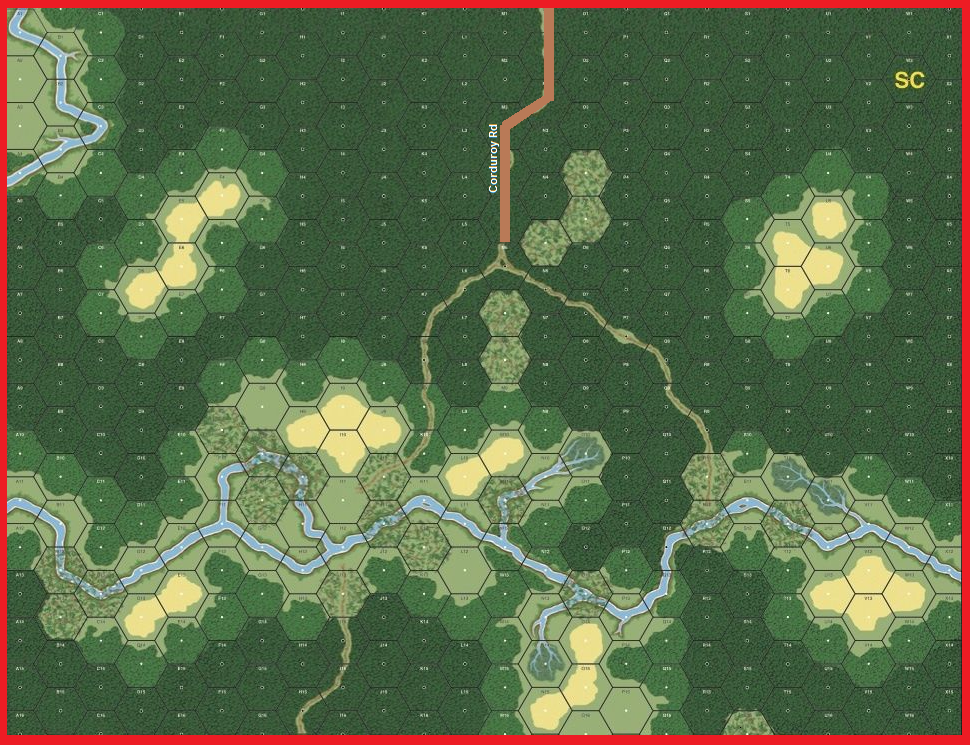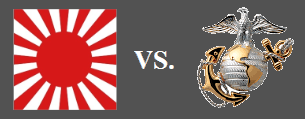| 2024-08-22 | (A) John Gorkowski | vs | John S | | American (USMC) win | 3 hrs | Fun lesson in night fighting, but I’m not sure this one was properly vetted as the USMC can avail a gamey setup that shuts down the IJN shot at victory.
The defending US has more squad equivalents with 18 to 14 Japanese, more small arms/MG firepower with 148 factors to 54, more MGs with 3 US HMG and 5 US MMG against 2 IJN LMG, more leaders 7 versus 3, more tanks 2 to 0, each side gets 2 DC. The Japanese do get a spotty inaccurate pre-game bombardment, but the Marines can set up in fox holes with plenty of cover. This all might make sense if SSR forced the Marines to disperse, but they don’t. To the contrary, SSR give the Marines automatic freedom of movement for two leaders vice dicing for just one as usual (E1.21) thereby taking a bite out of Japan’s night advantage.
Of crucial importance, the night time jungle battlefield is bisected by a road/trail network shaped like an inverted Y with a kunai field on either side of the Y’s stem. The Japanese approach from the south (opening of the Y) and must cross a muddy stream. The Marines have pickets along that stream with 80 FP and a rear area defense force with 68 FP factors (not including the Shermans and DC); note that each half of the US OB has more FP than the entire Japanese OB at 54! Again, if the Americans had to spread thin and were slow to react (as usual at night) that might make sense. But SSR allow them to react quickly and they can concentrate.
To win, the Japanese have to score 19 CVP, tabulated normally, with 5 CVP for capturing an ammo dump which set up HIP on or adjacent to the Kunai.
On defense, the Marines can “game” the scenario by defending only half of the battlefield, leaving one flank mostly open, but for dummies and a handful of real half squads to strip cloaking, inviting Japanese infiltration there. Once the Japanese lose cloaking, their movement through the dense jungle slows dramatically; they end up fighting the terrain. So, the US laughs while the Japanese either: 1) run into overwhelming firepower by attacking the defended half, or 2) waste a lot of time (half the scenario) trudging through dense jungle to discover a forest of dummy counters with no ammo dump! Although the rear has two kunai fields – one on the left half and one on the right half – the rear area Marines are not required to defend both. Therefore, they can put both supply dumps in one field along with most of their rear area OB including multiple HMG/MMG while staffing the other Kunai field with dummies and perhaps a few half squads to enhance the illusion.
Given their inferiority in number and FP, the Japanese basically have to choose one of three options as their main focus with a possible half-try at one of the others: 1) attack toward the right-side kunai to kill an ammo dump there, 2) attack toward the left side kunai to kill an ammo dump there, or 3) go up the middle in search of tanks to kill for CVP! Along the way, the Japanese hope to trounce enough USMC picket squads to up their CVP total. The tanks do afford CVP rich targets. The problem there is that they can just set up on the far board edge in line on the road with one half squad each as escort and get in motion ASAP, again an SSR allows them to move more easily than normal at night. Therefore, any tank hunter hero rushing those tanks (way late in the game given the distance to travel) would – at the very least - have to face point blank tank MGs, same hex half-squad FP, and only then get a crack at a moving target. That says nothing of the infantry platoon the Marines might start there or send that way to bolster the tanks given their automatic freedom of movement for two leaders.
Anyway, in our playing, the IJN started well. They concentrated on the American left (Japanese right) or east side of the map. The bombardment broke one USMC squad and one leader. The IJN crossed the stream on the first turn and killed one USMC squad in hand-to-hand combat, but not ambush so the USMC automatic freedom of movement kicked in. One of those USMC auto-move leaders ran afield to help other squads off their NO MOVE counters while some USMC stream pickets pulled back from the melee they witnessed. But, some swift IJN caught up to them, placed a DC to score a 2KIA and thereby kill two USMC squads and break their best leader (9-2). So, by the end of turn three, the IJN had killed three and a half USMC squads at the cost of only one IJN squad, overrun an HMG, and stood concealed on the edge of the right-side kunai field.
Then the concentrated US firepower took its toll. Since about 75% of the US OB had set up in the Japanese path, including 3 HMGs and 4 MMGs, they just started blasting away. For example, one US HMG directed by the now recovered 9-2 went on a rate tear to strip concealment, triple break two IJN squads, and kill their leader. There were multiple entrenched US stacks in the kunai field with 16+ FP. The IJN could not see the two HIP ammo dumps out there somewhere. So, the IJN nibbled away at the USMC in the kunai and took some down in hand-to-hand combat, but ultimately withered under massive US firepower. Given the dense jungle and US “check point” on the path the Shermans were too far away to reach in time. A smaller IJN force of four 3-4-7 squads did bleed its way up the middle, but the three US half squads sent to slow/whittle it down succeeded and kept the tanks out of reach.
Note, had the Japanese instead attacked on their left it would have taken three or four turns to discover a forest of fakes, not enough time left to slog across a board full of dense jungle in search of faraway CVP.
By turn 7, the Japanese had lost about 80% of their force (one intact 2nd line and a few broken half squads left) and accumulated 14 CVP, five short of the 19 required. Killing an ammo dump or tank would have put them over the top, but as noted those were at a distance behind a wall of US firepower. To balance this scenario, one might delete a USMC squad, MMG, or automatic freedom of movement, or not allow dummies to set up along the stream bank.
|



